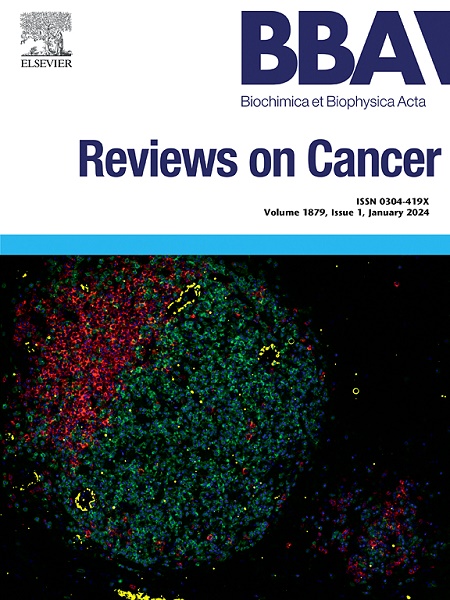通过多组学技术阐明非小细胞肺癌的细胞起源和TME动态进化
IF 9.7
1区 医学
Q1 BIOCHEMISTRY & MOLECULAR BIOLOGY
Biochimica et biophysica acta. Reviews on cancer
Pub Date : 2025-08-19
DOI:10.1016/j.bbcan.2025.189425
引用次数: 0
摘要
非小细胞肺癌(NSCLC)是癌症死亡的主要原因。尽管靶向治疗和免疫治疗取得了进展,但由肿瘤异质性和动态肿瘤微环境(TME)重塑驱动的耐药性仍然存在。多组学(单细胞/空间转录组学)揭示了肺泡2型(AT2)细胞的肺腺癌(LUAD)起源,以及SOX2/WNT/YAP通路驱动侵袭性亚型的谱系可塑性。TME是一个由免疫细胞和成纤维细胞组成的动态生态系统,它通过免疫编辑阶段和癌症相关成纤维细胞(CAF)/肿瘤相关巨噬细胞(TAM)的串扰进化,以促进免疫抑制。多组学鉴定出关键的免疫亚群(CXCL13+CD8+T细胞,M1/M2巨噬细胞)和抗原呈递癌相关成纤维细胞(apCAFs)作为治疗靶点。针对谱系可塑性、TME重编程和微生物组调节的新兴策略可能克服免疫检查点阻断(ICB)/酪氨酸激酶抑制剂(TKI)耐药性。解决时空异质性的挑战需要人工智能(AI)驱动的TME建模来指导精确干预。这篇综述强调了多组学在连接非小细胞肺癌进化和个性化治疗的临床转化方面的作用。本文章由计算机程序翻译,如有差异,请以英文原文为准。
Elucidating cellular origins and TME dynamic evolution in NSCLC through multi-omics technologies
Non-small cell lung cancer (NSCLC) is a leading cause of cancer mortality. Despite progress in targeted therapies and immunotherapy, resistance driven by tumor heterogeneity and dynamic tumor microenvironment (TME) remodeling persists. Multi-omics (single-cell/spatial transcriptomics) reveals lung adenocarcinoma (LUAD) origins in alveolar type 2 (AT2) cells and lineage plasticity via SOX2/WNT/YAP pathways driving aggressive subtypes. The TME, a dynamic ecosystem of immune cells and fibroblasts, evolves through immune-editing phases and cancer-associated fibroblasts (CAF)/tumor-associated macrophage (TAM) crosstalk to foster immunosuppression. Multi-omics identifies key immune subsets (CXCL13+CD8+T cells, M1/M2 macrophages) and antigen-presenting cancer-associated fibroblasts (apCAFs) as therapeutic targets. Emerging strategies targeting lineage plasticity, TME reprogramming, and microbiome modulation may overcome immune checkpoint blockade (ICB)/tyrosine kinase inhibitor (TKI) resistance. Challenges in spatiotemporal heterogeneity resolution call for artificial intelligence (AI)-driven TME modeling to guide precision interventions. This review highlights multi-omics in bridging NSCLC evolution with clinical translation for personalized therapies.
求助全文
通过发布文献求助,成功后即可免费获取论文全文。
去求助
来源期刊

Biochimica et biophysica acta. Reviews on cancer
医学-生化与分子生物学
CiteScore
17.20
自引率
0.00%
发文量
138
审稿时长
33 days
期刊介绍:
Biochimica et Biophysica Acta (BBA) - Reviews on Cancer encompasses the entirety of cancer biology and biochemistry, emphasizing oncogenes and tumor suppressor genes, growth-related cell cycle control signaling, carcinogenesis mechanisms, cell transformation, immunologic control mechanisms, genetics of human (mammalian) cancer, control of cell proliferation, genetic and molecular control of organismic development, rational anti-tumor drug design. It publishes mini-reviews and full reviews.
 求助内容:
求助内容: 应助结果提醒方式:
应助结果提醒方式:


